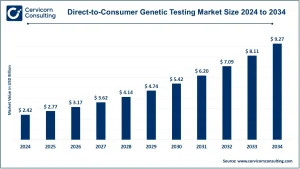Market Overview
The U.S. life science tools market was valued at USD 49.35 billion in 2024 and is forecasted to reach USD 111.32 billion by 2034, expanding at a CAGR of 7.98% during 2025–2034. These tools—covering instruments, reagents, consumables, and digital platforms—serve as the foundation for biomedicine, diagnostics, biotechnology, and academic research, driving progress in genomics, proteomics, and laboratory automation.
📌 Get a Free Sample: Cervicorn Consulting
Key Market Trends
1. AI and Automation Adoption
More than 62% of biotech and pharmaceutical laboratories in the U.S. are already using some form of automation or robotics. AI-powered platforms are optimizing genomic sequencing, diagnostics, and drug discovery by improving data interpretation and reducing errors.
2. Advancements in NGS and CRISPR
The rise of next-generation sequencing (NGS) and CRISPR gene-editing tools is revolutionizing disease modeling, personalized medicine, and drug development—driving higher demand for sequencing systems and consumables.
3. Expansion of Cloud-Integrated Lab Platforms
Around 55% of U.S. life science firms now leverage cloud-based data solutions, enabling real-time collaboration, advanced analytics, and enhanced regulatory compliance.
4. Regulatory Shifts Affecting Supply Chains
Export restrictions on high-tech lab equipment, such as flow cytometers and mass spectrometers, especially toward China, underline national security priorities. Meanwhile, the National Biotechnology Initiative Act (2025) is fostering long-term growth opportunities through multi-agency biotech support.
5. Move Toward Preventive Healthcare and Precision Medicine
Growing reliance on molecular diagnostics and personalized healthcare solutions—ranging from oncology to reproductive health—is driving innovation and positioning life science instruments as vital components of precision medicine.
Market Drivers
-
R&D Spending Growth
U.S. universities invested USD 97.8 billion in R&D during 2023, with 64% allocated to life sciences. Additionally, over 1,800 biotech and life science firms utilized federal R&D tax credits, underscoring strong funding support. -
Government Investments
The NIH committed nearly USD 26.4 billion in 2024 to life science and healthcare R&D. Despite fluctuations in 2025, the U.S. continues to lead globally in research spending, boosting demand for cutting-edge lab technologies. -
Technological Innovations
Breakthroughs in high-throughput sequencing, advanced mass spectrometry, and imaging are improving scalability and precision in labs, while reducing costs and accelerating therapeutic development. -
Import Reliance and Global Collaboration
The U.S. imported more than USD 15 billion worth of scientific instruments—largely from Germany and Japan—highlighting both the reliance on international supply chains and opportunities for strategic collaboration.
Impact of Trends and Drivers
-
Pharma & Biotech: AI and automation shorten drug discovery timelines and strengthen diagnostics.
-
Academic Research: Federal and university funding enhances genomic and proteomic breakthroughs at leading institutions such as Johns Hopkins, UCSF, and Harvard.
-
Diagnostic Laboratories: The shift to molecular testing and personalized medicine sustains demand for sequencing and imaging platforms.
-
Regional Dynamics: Export controls may accelerate domestic innovation and localized manufacturing growth.
Challenges & Opportunities
-
Challenges: Funding volatility, regulatory uncertainties, and reliance on imports remain key risks.
-
Opportunities: AI integration, federal biotech initiatives, and the rise of precision healthcare open new pathways for both established leaders and emerging companies.
Future Outlook
By 2034, the U.S. life science tools market is projected to surpass USD 111.32 billion. The combined impact of digital transformation, robust R&D, and supportive policies will continue reshaping the industry. The increasing convergence of AI, automation, and precision medicine will not only accelerate research but also redefine diagnostic and therapeutic landscapes over the next decade.
👉 Read Full Report: Cervicorn Consulting
